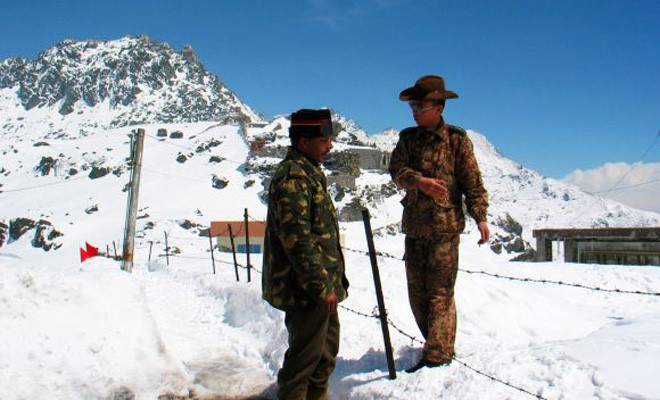 Incursions from China continue despite protests and meetings by India. It is reported that on 20 August 2013, there were intrusions by China in the Walong- Choglagam sector in Arunachal Pradesh which resulted in erection of tents by troops of both sides. This follows the Depsang Plains incident of April 2013 and the Chumar incident thereafter. China has also operationalised two airfields in Tibet. These are the Ngari-Gunsa near Shihquanhe opposite Demchok in Ladakh and Bangda North opposite Arunachal Pradesh. As per reports, a dozen more airfields have been planned in Tibet.
Incursions from China continue despite protests and meetings by India. It is reported that on 20 August 2013, there were intrusions by China in the Walong- Choglagam sector in Arunachal Pradesh which resulted in erection of tents by troops of both sides. This follows the Depsang Plains incident of April 2013 and the Chumar incident thereafter. China has also operationalised two airfields in Tibet. These are the Ngari-Gunsa near Shihquanhe opposite Demchok in Ladakh and Bangda North opposite Arunachal Pradesh. As per reports, a dozen more airfields have been planned in Tibet.
The intrusions are well coordinated and show marked interest by the PLA in areas of military significance. It is perhaps a signal by the new leadership in China to indicate that along with diplomatic activity, China will adopt an assertive stance on the issue of territorial claims and sovereignty. It could also be deduced that the actions of the PLA are to restrain India in building up infrastructure in the border areas. Also, by slowly biting into pieces of Indian Territory through continuous intrusions, the Chinese are observing how India’s political leadership and its security forces react to such provocation.
Ever since the new leadership has taken charge in March 2013 there have been aggressive statements by outspoken Chinese military officers about their military capabilities. It is extremely difficult to probe the Chinese military mind but Chinese military doctrine is focused towards winning short duration border wars. The PLA is training for short and swift conflict preceded by a cyber-offensive. An offensive could involve the use of missiles, anti-satellite weapons, overwhelming firepower and control over the air space. The extent and scale of conflict would depend on Chinese motives and intent.
Another aspect for consideration is the consolidation of the string of pearls strategy. While Pakistan has always been closely allied with China, Beijing is asserting increasing influence on Nepal, Sri Lanka, Myanmar, Bangladesh, and Maldives and in a mild manner, Bhutan. The question to ask is “What Is the Chinese Objective”? Various possibilities exist. It could be to lower India’s image in the region and to keep India confined to the backwaters of South Asia. It could also be to demonstrate power to the Chinese people who of late have been indulging in protests and violent disturbances in Inner Mongolia, Tibet and Xinjiang. How then should India respond to such unfriendly acts?
Diplomatically, India must proactively resolve all issues and differences with Bangladesh, Nepal, Sri Lanka, Myanmar and Bhutan. As regards Pakistan, the policy towards border violations and inflow of terrorists from across the border, demand a firmer response. Along the LAC with China, there must be a renewed emphasis laid on patrolling and surveillance using satellites, unmanned aerial vehicles (UAVs) and battle field surveillance radars. While the formations on the Chinese border are ever vigilant, use of technology is essential to have total visibility over our areas of concern.
Three issues need to be addressed expeditiously. These would transform our existing policy of dissuasion with China to limited deterrence. First is the raising of additional forces which have already been sanctioned by the government. This is a welcome step and when completed, will increase military capability to a large extent. It must be appreciated that the mere intent of raising additional forces has sent an important signal that the nation will protect its territorial integrity. The raisings must now be completed expeditiously to ensure peace on our Northern borders.
The next aspect relates to equipping our forces on the Northern border with missiles. China’s Second Artillery has already deployed ballistic and cruise missiles in Tibet and in the Qinghai province at Delinga. India has tested the Agni V successfully, but five more tests are required which must also be carried out in a shorter time frame. The missile must thereafter be operationalised for deployment with strategic forces. The Chinese have also deployed conventional missiles in Tibet. These must be countered by deployment of the BrahMos missile. The last and perhaps the most vital aspect relates to the development of infrastructure. There are 72 roads to be constructed out of which work has commenced only on 32. Most of them are stuck due to problems of environmental clearance and acquisition of land. There is a requirement of expediting the entire process.
In addition, while China has cultivated countries around our periphery there is a need for India to build military partnership with like minded countries. It would be prudent for us to consider Vietnam, Japan and Taiwan for cooperation in the military and other domains. It is only through a strong show of defence preparedness that the integrity of our borders can be maintained. India must hence move from a policy of dissuasion to deterrence.
By Special Arrangement with The Centre For Land Warfare Studies (CLAWS) (http://www.claws.in)